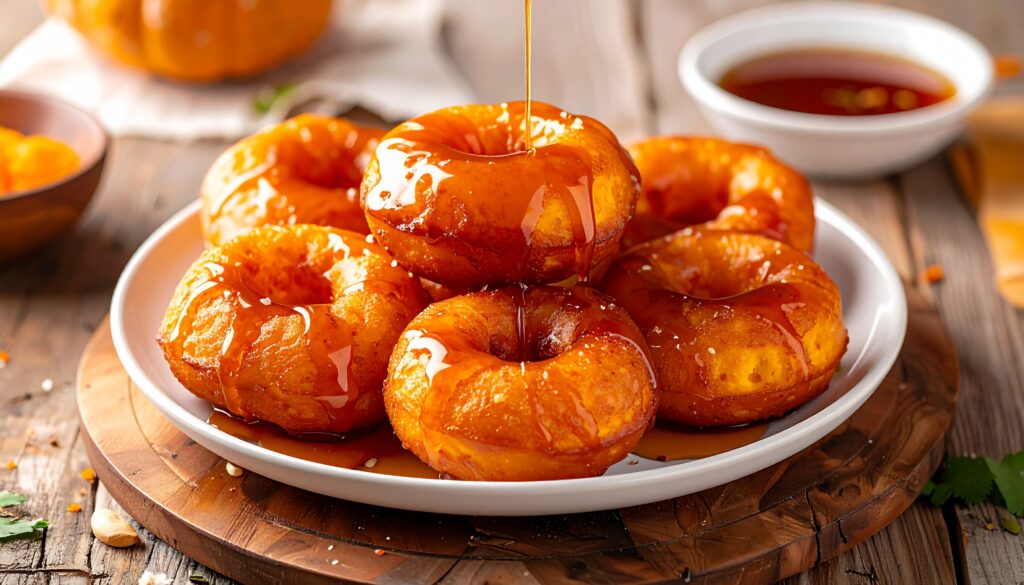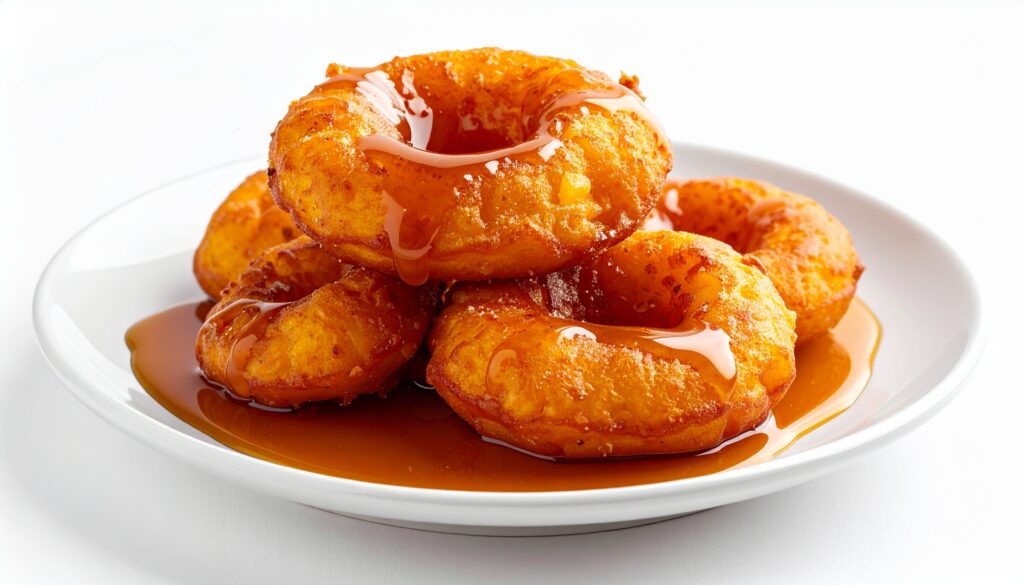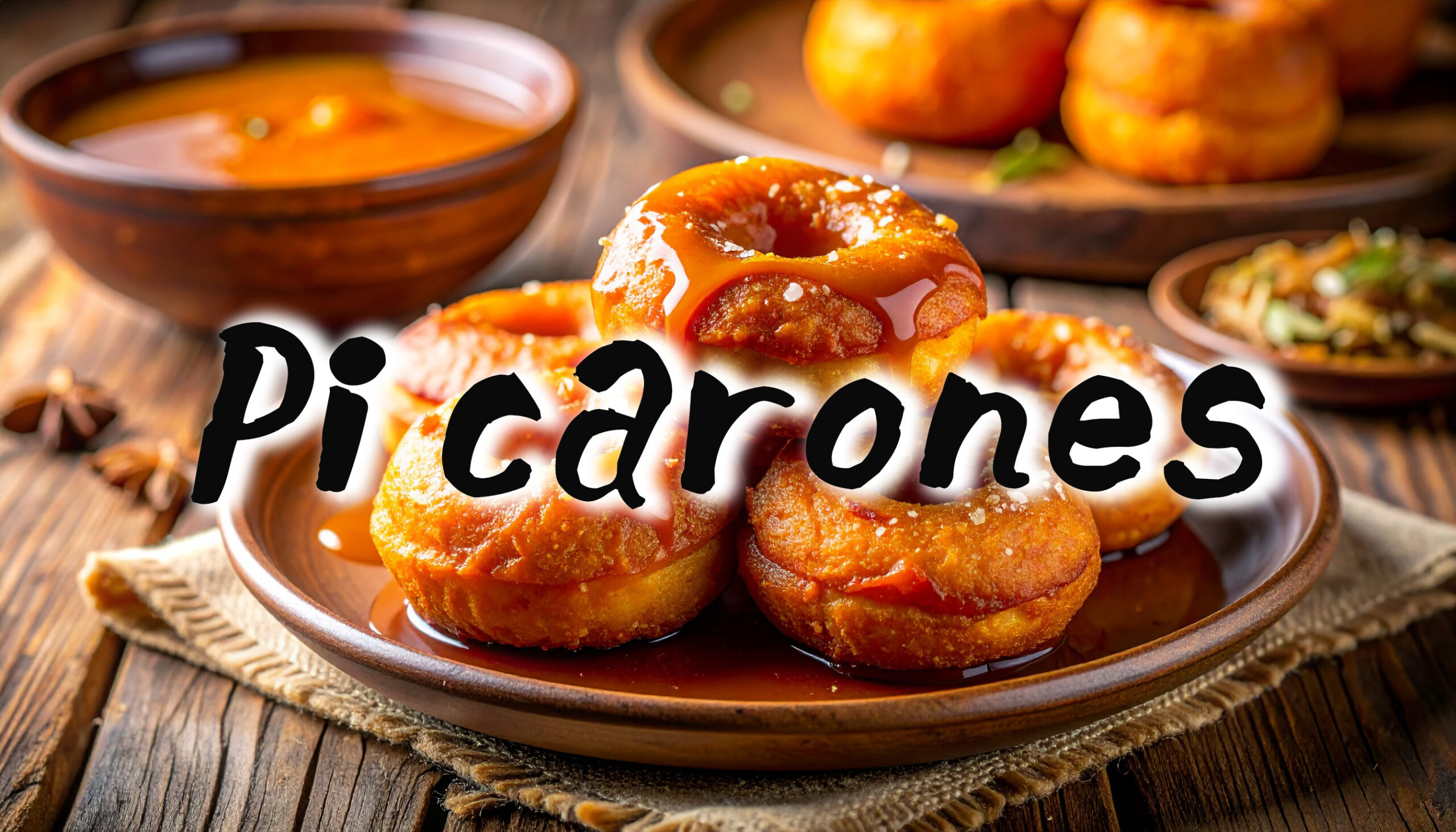Do you know what picarones are?
Picarones look like doughnuts and are made using pumpkin or_ sweet potato.
Crispy on the outside, soft and chewy on the inside, with a rich, fragrant flavor soaked in syrup.
This time, we've compiled everything about picarones—from their history to how they're made!
Enjoy it to the very end!
TasteTune introduces diverse cuisines from around the world and also delivers music that expresses those dishes.
Available on various subscription services like YouTube and Spotify, so enjoy it along with this article.
What is picarones?

Picarones are a type of doughnut popular in Peru, characterized by the use of sweet potatoes and pumpkin in addition to wheat flour.
The vendor, known as a picaroneira, scoops the soft dough with wet hands, forms it into a ring shape by pressing a hole in the center with her thumb, and drops it into the hot oil.
This traditional method results in a crispy, fragrant exterior and a soft, chewy texture inside.
The finishing touch is typically drizzling a syrup made by boiling down brown sugar with cinnamon and citrus peel (Miel de Chancaquita).
This syrup enhances the simple flavor and aroma.
While they resemble doughnuts in appearance, the key difference lies in the dough, which incorporates sweet potato or pumpkin purée, resulting in a distinctive flavor and moist texture.
TasteTune「Picarones」
Hey everyone, have you heard Tastetune's song “Picarones”?
This music is a cheerful and energetic piece inspired by picarones, expressing their sweet flavor and the lively atmosphere of Peru's bustling night markets through sound.
This piece invites listeners to a street carnival in Peru, expressing the warmth and joy found in traditional sweets. Please give it a listen!
Below, we introduce the thoughts, expressions, and creative approaches embodied in this musical work.
Crisp texture and melting sweetness: A taste painted with sound
At the heart of this piece is the reflection, through sound, of the joy and indulgence inherent in picarones cooking.
The sizzling sound of batter hitting hot oil crackles and pops like the lively laughter at a night festival, resonating as a heart-stirring rhythm.
It lets you hear the light texture of picarones and the liveliness of the moment they're made.
And the amber syrup clings to the dough with a silky smoothness, expressed through layers of sweet, expansive sounds, evoking the blissful sweetness that arrives with every bite.
The Rhythm and Energy of Celebration
The entire piece overflows with a festive energy.
The light flute melody and rhythmic percussion sounds are like the footsteps of people dancing at a street carnival.
Simply being enveloped in sound naturally brings a smile to your face and evokes a sensation of your body swaying.
This sound conveys the cheerfulness and warmth inherent in Peruvian tradition, telling us that picarones are not just a dessert, but a special presence that connects people and shares joy.
A Tale of Sound Weaving Warmth and Happiness
This work conveys warmth, joy, and a sense of happiness. Alongside the sweet taste of syrup, you can sense the bright spirit inherent in Peruvian culture.
It is an experience that goes beyond the simple pleasure of eating, reminding us of the connections between people and the time that fills our hearts.
The Essence of Picaronés to Savor with Your Ears
This piece of music is not just background music.
Picarones embody a “sweet indulgence,” the “bustle of cooking,” and the “joy of celebration”—a true work of art to savor with your ears.
Surrendering to the sound, the scents drifting through the streets of Peru and the smiles of its people seem to appear before you.
Please surrender your heart to this journey of sound and fully immerse yourself in the world of Picaroness.
The History of picarones

The beginning dates back to before the 16th century.
In the Andes region at that time, sweet potatoes and pumpkins were eaten on a daily basis.
It is said that the practice of grinding these ingredients into a paste and eating them led to the origin of picarones.
This became the current form of picarones during the Spanish colonial era of the 16th century.
The catalyst was the introduction of a fried pastry called “buñuelo” by Spain.
However, in Peru, flour and sugar were expensive items, making it difficult to prepare them.
Therefore, a dough made by mixing locally grown pumpkin and sweet potato was devised, and this led to the picarones we know today.
Picarones have since become known primarily in Peru's capital, Lima, through home baking and street vending.
The 1798 document Lima por dentro y fuera contains a description of picarones.
This is considered the oldest extant written record.
Since the 19th century, picarones have become a staple dessert in Peru.
Around this time, picaroneiras began appearing on the streets and in the markets of Lima.
Picaronera refers to someone who makes and sells picarones, specifically female street vendors.
After the 20th century, it became widely known abroad as well.
It has earned high praise in global fried snack rankings and is now featured in tourism and culinary culture promotions.
Furthermore, in 2011, the Peruvian Ministry of Culture designated picarones as a “National Cultural Heritage.”
Picarones Trivia
Religion and picarones
Picarones are a culinary heritage linked to faith and community spirit in Peru.
While it is also made at home, it is often sold at stalls during religious events as a symbol of “sharing, giving, and celebration.”
The act of eating itself serves to strengthen the sense of solidarity among participants in religious ceremonies.
Additionally, in Peru, the Señor de los Milagros festival is held every October.
This is Peru's largest religious event, featuring a Catholic procession in Lima.
Around this time of year, picarones stands line the streets throughout town.
Variations of picarones
Picarones are basically made by frying dough made from pumpkin and sweet potato, then drizzling them with brown sugar syrup, though there are several variations depending on the region and household.
Here are a few examples.
Difference in ingredients
- Recipe using yuca (cassava) instead of sweet potato.
- A recipe that increases the proportion of pumpkin for a softer texture and richer flavor.
- Some households add extra flour to achieve a texture closer to that of a doughnut.
Sweetness Variations
- A recipe for adding honey and sugar to brown sugar (chanka) syrup.
- A regional flavor profile infused with orange peel, anise, cloves, and cinnamon in the syrup.
- Outside Peru, modern variations exist that feature maple syrup or chocolate sauce.
Design Innovation
- Traditionally ring-shaped, but they can also be fried in a round, flat shape or as small dumplings.
- Some food stalls offer smaller portions specifically for eating on the go.
The Origin of the Name picarones
The name picarones comes from the Spanish word “pícaro,” meaning “mischievous,” and is meant to evoke the idea of a sweet treat you just can't resist reaching for.
Named for its mischievous and charming appeal, this treat embodies a deliciousness that's impossible to stop eating once you start.
Its light and tempting flavor has made it beloved as a “playful treat.”
Almíbar de chancaca
Almíbar de chancaca is a traditional Peruvian syrup made by dissolving brown sugar (chancaca) and flavoring it with cinnamon, cloves, and orange peel. It is served poured over fried picarones.
This syrup, a unique Peruvian sweetener made by boiling down brown sugar, enhances the appeal of picarones with its rich aroma and intense flavor.
How to Make picarones
Ingredients (Serves 4)
- Pumpkin … 300g
- Sweet potato … 200g
- Bread flour … 250g
- Dry yeast … 7g
- Sugar … 2 tablespoons
- Salt … a pinch
- Water … approximately 100ml
- Cooking oil … as needed
- Chankaka (brown sugar) syrup … to taste
How to make them
- Preparing root vegetables
First, peel the pumpkin and sweet potato, then cut them into bite-sized pieces.
Then steam or boil until tender, and mash with a fork or blend until smooth. - Fabric production
Next, add sugar, salt, dry yeast, and water to the puree and mix well.
Gradually add the all-purpose flour and knead by hand until the dough becomes elastic.
After that, cover with plastic wrap and let it ferment in a warm place for about an hour. - Shape it
Once fermentation is complete, transfer the dough to a lightly floured surface.
Then, roll it into a small ball, use your finger to make a hole in the center, and shape it into a ring. - Fry
Heat oil to 170–180°C (340–378°F), add the batter, and fry until both sides are golden brown.
After frying, drain off excess oil with paper towels. - Finishing
Finally, pour the Chanka syrup over it while it's still warm.
Thus, the fluffy and fragrant picarones are complete.
Points
- Thorough fermentation results in a light and fluffy texture.
- For a more traditional flavor, flavor the syrup with spices or orange zest according to your preference.
Summary
How was it?
This time, we've compiled information on picarones, a traditional Peruvian sweet!
As I researched this, I realized that there are many regions and countries where traditional cuisine is closely tied to religion.
This year's picarones had become inseparably intertwined with religious events in Peru.
It's not just about sweets; I truly believe it's wonderful that we can learn about history and people's feelings through these kinds of relationships.
In Japan, you can eat picarones at Peruvian restaurants and similar establishments.
Also, you can make it yourself at home, so I really hope you'll try making it and savoring it.
I'd be delighted if reading this article sparked your interest in picarones.
Thank you for staying with us until the very end!




Comment